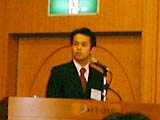![]()
| S-9-13 Effect of topical application of glycosaminoglycan in wound healing. |
| Y. Takae, S. Izaki, K. Kitamura, Y. Hori, T. Sakai and M. Kyogashima. Dermatology, Saitama Medical Center, Saitama Medical School, Kawagoe, Japan and Seikagaku Corp., Tokyo Res. Inst., Tokyo, Japan. |

![]()
Glycosaminoglycans (GAGs), such as dermatan sulfate(DS), distributed in connective tissue of the skin have been implicated in wound healing through regulation of growth of fibroblasts and endothelial cells and matrix protein assembly. The authors tested effect of topical application of 0.5% DS in petrolatum (DS ointment) on wound healing of skin ulcer with 8 mm in diameter cut under anesthesia on the back of SD strain female rats. Ulcer area of control rats treated with petrolatum vehicle only showed decrease in size to 50% of initial dimension 7 days after operation, and 90% healing was shown in 11 days. Use of DS ointment led to 50% healing in 5-6 days and 90% in 9 days. Histological examination revealed proliferative effect for fibroblastic cells with abundant matrix production in DS ointment-treated rats than in the in control group suggesting that topical DS played a role to modulate function of fibroblastic cells. Vascularization was dominantly observed in DS ointment-treated rats than in control animals, suggesting a role of DS in angiogenesis in the wound healing. Biological significance of the role of DS was tested in experimental dermatitis induced in NC/Nga mice, resulting in earlier healing from scratch damage, accordingly better control of the dermatitis. Topical DS may be useful agent to treat skin ulcer and excoriated dermatitis.
![]()